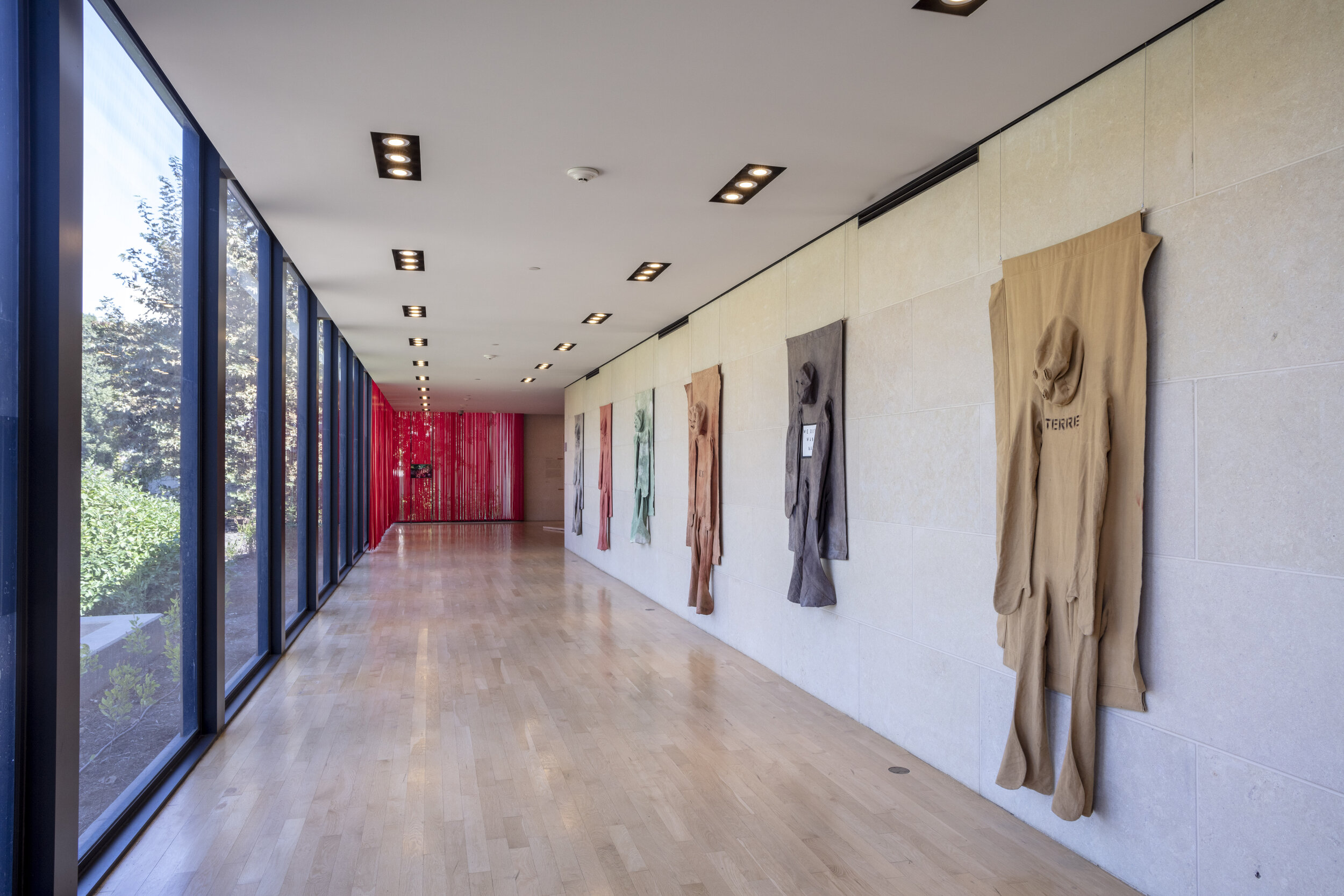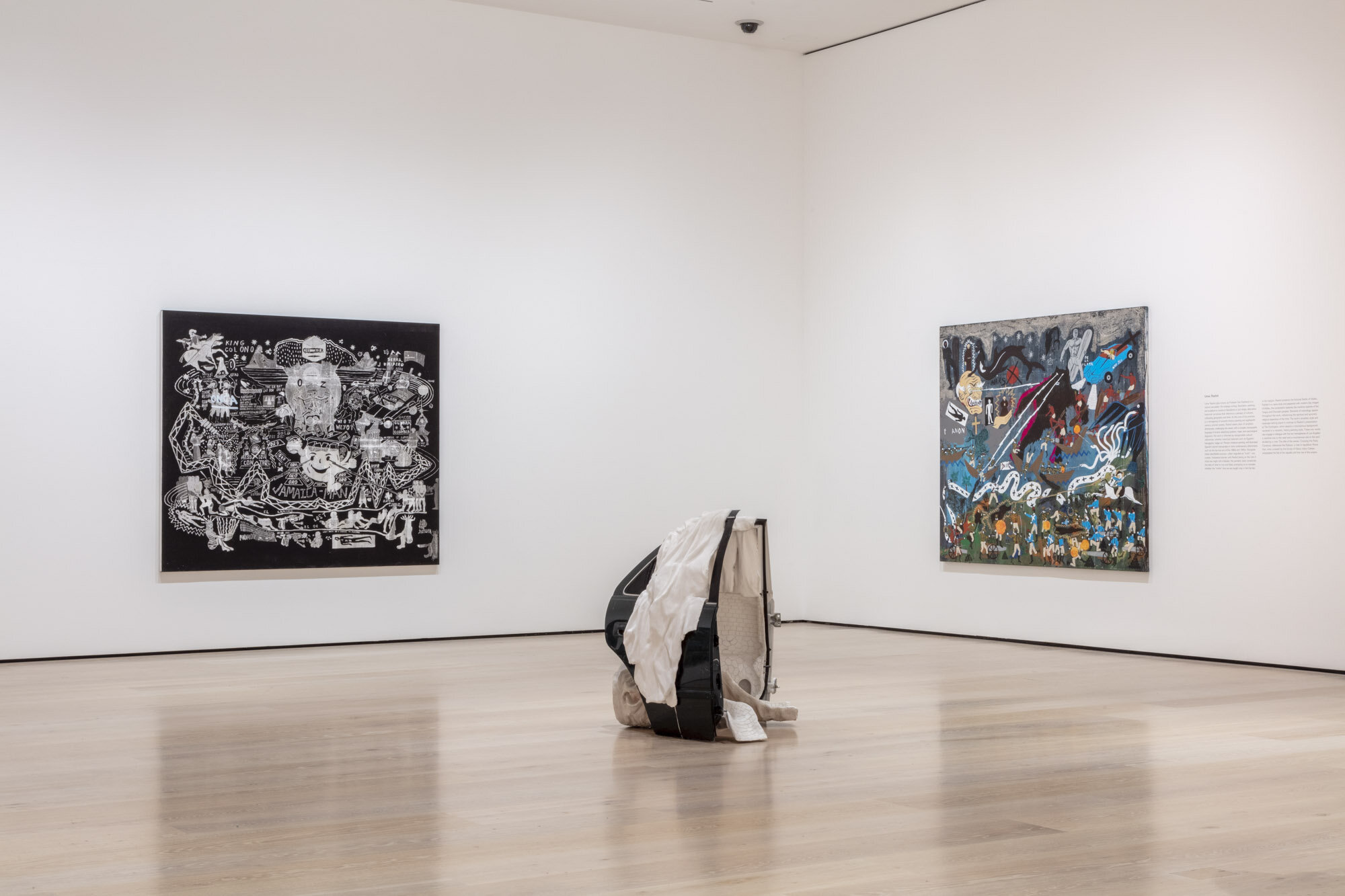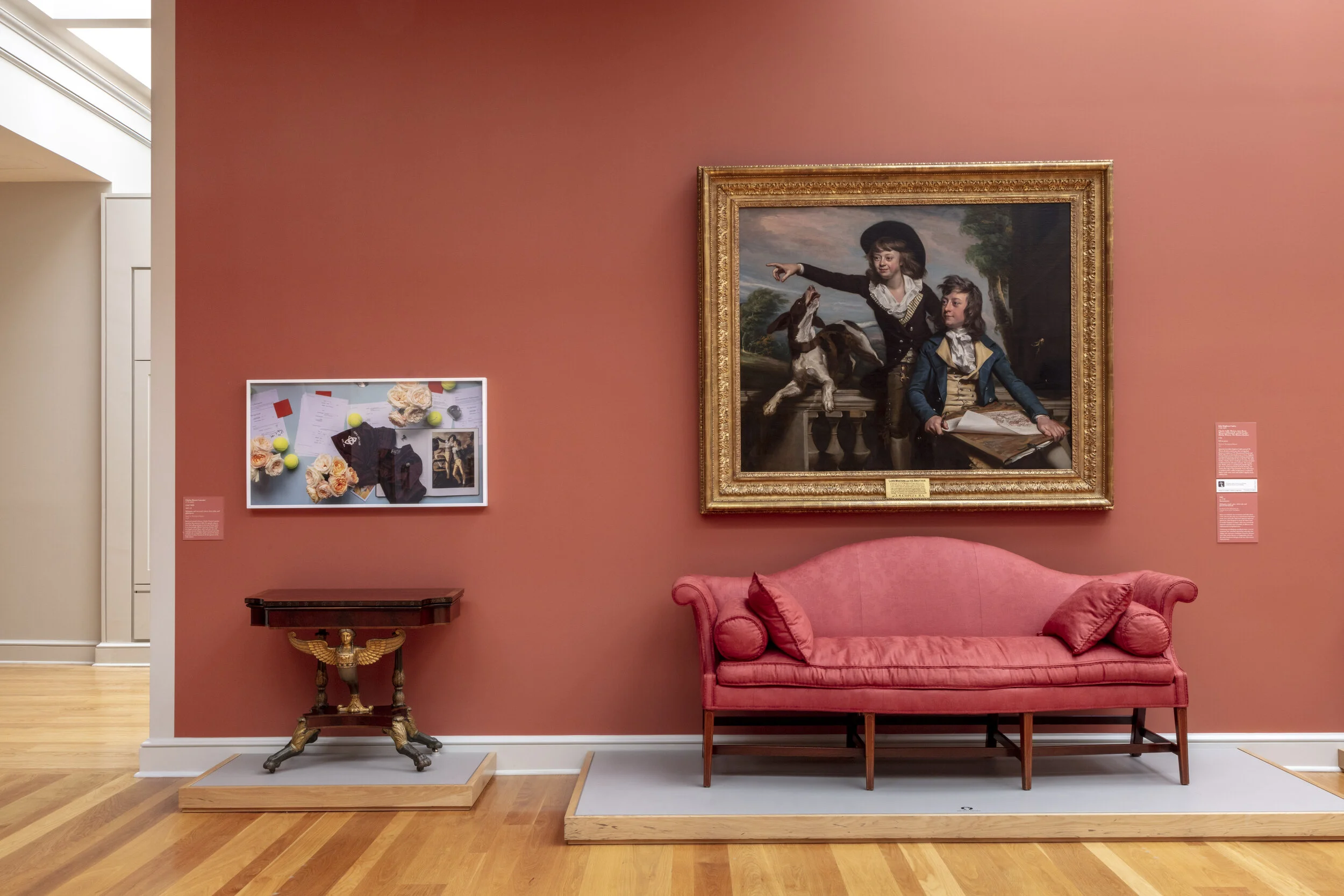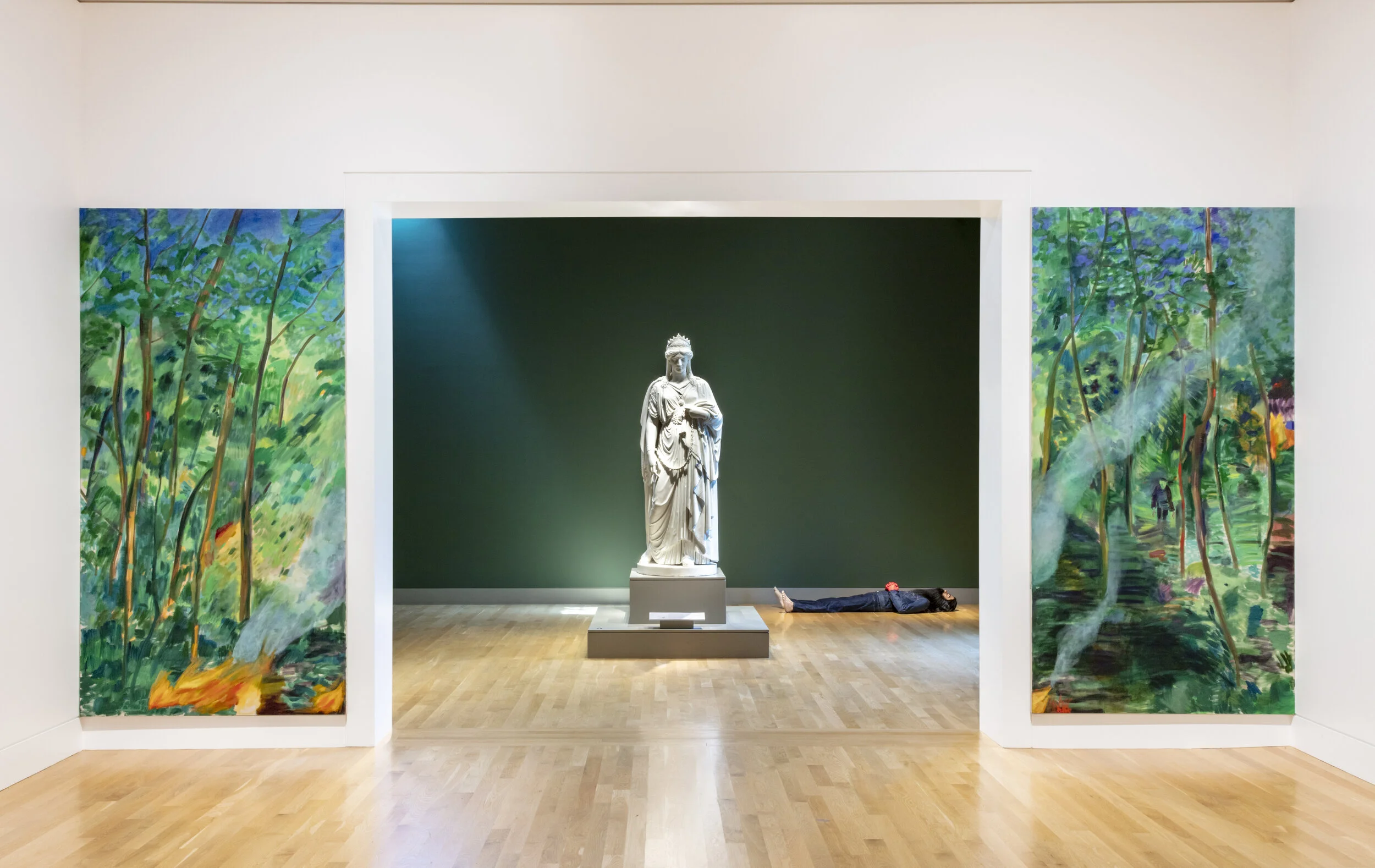Fact or Fiction: Storytelling in the ‘Made in L.A. 2020: a version’ Biennial Exhibition
Made in L.A. 2020: a version. Installation view at The Huntington Library, Art Museum, and Botanical Gardens, San Marino. Photo: Joshua White / JWPictures.com.
In an era of fake news, story spinning and the increasing importance of “fact-checking,” the need for examining ideas of authority when it comes to storytelling are greater than ever before. Coincidently, the exploration of what is real and what is not is particularly relevant to the city of Los Angeles with its roots in the entertainment industry and history as a center of manufactured storytelling. Thus, it comes as no surprise that the dismantling of artifice, and examining of the relationship between fact and fiction are themes currently being addressed by artists living and working in Los Angeles today.
This rethinking of authority in terms of the stories we tell and the creation of exhibitions, collections and archives remains a central theme in the new “Made in L.A. 2020: a version” biennial exhibition presented by the Hammer Museum and Huntington Library, Art Museum, and Botanical Gardens. This was a theme that came up quite often in conversation among curators Myriam Ben Salah, Lauren Mackler and the Hammer’s Ikechukwu Onyewuenyi and the nearly 300 artists they interviewed in the preparation for this exhibition.
Kahlil Joseph, BLKNWS®, 2018–ongoing. Two-channel fugitive newscast. Courtesy of the artist. Installation view, Made in L.A. 2020: a version, Hank’s Mini Market, Los Angeles. Photo: Jeff McLane.
While not yet open due to COVID-19 restrictions, the show is the fifth iteration of the Hammer’s biennial exhibition highlighting the work of 30 artists living and working throughout greater Los Angeles. With a nod to the ever expanding urban sprawl that is Los Angeles, this exhibition inaugurates a crosstown dialogue bringing the east and west of the city together with “mirror” exhibitions being presented at both institutions, as well as select off-site and online interventions in between. Breaking the boundaries of a traditional exhibition, the works presented are not necessarily confined to the walls of the museum. There are also a number of pieces scattered throughout Los Angeles including Larry Johnson’s site specific works presented on five commercial billboards in MacArthur Park and Kahlil Joseph’s installation of BLKNWS, a conceptual news program blurring the lines between art, reporting, and cultural critique, hosted at predominately black-owned businesses such as barbershops, cafes, and centers of community gathering.
What strikes me most in the examining of authority within these works are the opportunities for dialogue that arise when presenting contemporary work inside the Huntington, a cultural institution known for presenting the first Old Masters collection in Los Angeles and renowned for its extensive collection focusing on 18th and 19th-century European art and 17th to mid-20th-century American art. According to President Karen Lawrence, the Huntington’s participation in the ‘Made in LA’ exhibit is part of the museum’s centennial commitment to not only look back but forward and “ensure that the historic collections remain alive and open to new study and interpretation by a diverse group of students, scholars, artists and writers.”
In preparation for this exhibition, says curator Lauren Mackler, the Huntington became an influential counterpoint for the biennial and many artists began “rethinking the notion of archives, and challenging the traditional mode of exhibiting archives which brought issues to the forefront (…) and led artists to consider how archives are related to authority and how authority can be re-evaluated through display tactics.”
Paintings by Umar Rashid and sculpture by Ann Green Kelly. Made in L.A. 2020: a version. Installation view at The Huntington Library, Art Museum, and Botanical Gardens, San Marino. Photo: Joshua White / JWPictures.com.
Particular works that stand out in this way include the paintings of Umar Rashid (also known as Frohawk Two Feathers). In his reimagining of romantic history painting and 18th-century colonial scenes, Rashid constructs fantastical, alternative historical narratives that prompt us to consider notions of what is fact, what is fiction and whether the “truths” we take for granted are in fact lies. A natural born storyteller, Rashid’s work presents a cultural and historical mashup and re-envisoning of the paths of populations often omitted from history through a complex iconographic language using symbols, maps and cosmological diagrams.
In his series at the Huntington, entitled Crossing the Ruby Construct, Rashid presents a “critique of Spanish - controlled colonial California and the depradations of the indigenous people through the mission system.” Composed in the tradition of French Romantic painter Eugene Delacroix and the Baroque master Peter Paul Rubens, these paintings portray the aftermath of rebel indigenous forces rising up against their oppressor. The romantic style and mountainous background presented in these paintings at the Huntington contrasts with Rashid’s triptych at the Hammer Museum which presents the fictional Battle of Malibu, exploring the maritime exploits of the Tongva and Chumash peoples. As the curators point out, the placement of the works in their respective museums reflect their relationship to the topography of Los Angeles’ two hemispheres.
Paintings by Umar Rashid and sculpture by Ann Green Kelly. Made in L.A. 2020: a version. Installation view at Hammer Museum, Los Angeles. Photo: Joshua White / JWPictures.com.
Buck Ellison’s ‘Untitled (cufflinks)’ alongside John Singleton Copley’s ‘The Western Brothers.’ Made in L.A. 2020: a version. Installation view at The Huntington Library, Art Museum, and Botanical Gardens, San Marino. Photo: Joshua White / JWPictures.com.
Buck Ellison’s Untitled (cufflinks), displayed alongside John Singleton Copley’s The Western Brothers in the permanent collection of the Huntington’s Gallery of American Art is an almost comical confrontation of white, American wealth, which is so often represented in older and more established institutions like the Huntington. Ellison’s still life depicts a staged arrangement of tennis balls, lacrosse shorts, a New York Times wedding announcement and book open to The Allen Brothers (Portrait of James and John Lee Allen) by Scottish portraitist Henry Raeburn. As the only work from the ‘Made in LA’ exhibit intentionally placed inside a separate gallery of the permanent collections at the Huntington, the work speaks to this theme of breaking traditional boundaries, creating dialogue between different realities and the past and present, as well as embracing new perspectives of history.
In presenting Ellison’s work in this way and also that of other contemporary artists in the exhibition, the Huntington is incredibly successful at encouraging an open dialogue, allowing their collection to be a jumping off point for artists in service of embracing new perspectives around these works.
Photo collage by Kandis Williams. Made in L.A. 2020: a version. Installation view at The Huntington Library, Art Museum, and Botanical Gardens, San Marino. Photo: Joshua White / JWPictures.com.
A large-scale photo collage by Kandis Williams presents Henry E. Huntington, billionaire and founder of the museum, merged with Goya’s rendition of the monstrous Greek god Saturn in an unsettling interplay of images culled from magazines and archival documents. The life-size collage works on view are the result of the artist’s research in The Huntington’s various collections, with a particular focus on the history, discovery, and nomenclature of so-called invasive species.
This dialogue is equally present in the work of Monica Majoli and her series called Blueboys, named after one of the earliest national gay magazines founded by Donald N. Embinder and published from 1974 to 2007. Her series of paintings focusing on centerfold figures of the magazine highlights the challenges of creating an archive of history that was suppressed at the time of its initial circulation. The magazine shares its name with the famous portrait by eighteenth-century painter Thomas Gainsborough, which is part of the Huntington’s permanent collection.
Paintings by Jill Mulleady and Installation by Patrick Jackson. Made in L.A. 2020: a version. Installation view at The Huntington Library, Art Museum, and Botanical Gardens, San Marino. Photo: Joshua White / JWPictures.com.
In addition to the study of fact verses fiction, a certain nightmarish, aesthetic of horror appears to be present throughout the show. At first a puzzling one, the theme of horror presents itself in a similar way— is what’s presented before us a nightmare or is it reality—and which is scarier?
With an interactive Halloween-style, haunted house by Sabrina Tarasoff, the haunting doubling up of a painting by Fulton Leroy Washington aka “Mr. Wash” exhibited at both museums, and the nature of the show as reminiscent of a certain type of parallel universe with each “mirror” exhibition presenting a full experience at both museums, this theme is an interesting examination of what is fan-fare fiction verses reality.
Finally, the last part of the name of this exhibition, “a version,” hits this idea home, speaking to questionable nature of storytelling and whether a story can ever really be true, as it presents only a version.






